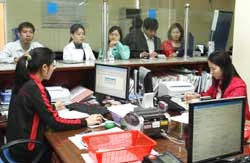More cash pours in from overseas Vietnamese
 |
| Customers exchange foreign currency at a VietinBank's branch in northern Phu Tho Province. The World Bank predicts inward remittance will increase by over 6 per cent this year, after it passed $8 billion in 2010. |
Inward remittances to Vietnam increased strongly in the last decade, from only $1.2 billion in 1999 to $7.2 billion in 2008.
Last year was the first time in which remittances surpassed $8 billion, a rise of 25.6 per cent over 2009.
The recovery of the world economy as well as better economic growth have opened more business opportunities, with more and more overseas Vietnamese transferring money to invest here.
With a more liberalised remittance policy, including allowing the sending and receiving of US dollars, commercial banks as Sacombank and Vietcombank have taken many measures to attract foreign currencies.
These include diversifying payment channels and upgrading service quality, both of which are fueling overseas remittances.
In addition, a higher interest rate on the US dollar and an appreciation of the US dollar to the local currency in Vietnam have also encouraged overseas Vietnamese to send money back.
According to the State Bank of Vietnam (SBV), the interbank lending interest rate on the world market fluctuates between 0.23-0.78 per cent per year.
But the commercial banks in Vietnam have applied deposit interest rates of about 5 per cent a year, some banks, 6-6.3 per cent.
Compared to 2009, the official exchange rate between the US dollar and local currency last year increased by about 5.53 per cent.
Remittances are an important source of foreign currency, significantly contributing to reduce the trade deficit and aid the country's economic development.
But a strong surge in inward remittances may cause side effects, including depending too much on foreign capital and causing difficulties for the SBV in monetary control, experts have said.
In addition, with big differences in exchange rates between banks and the open market, a large amount of dollars from remittances have been sold to the latter.
This has increased the amount of foreign currency circulating outside the banks, encouraging the dollarisation of the economy.
Apart from remittances sent to Viet Nam for investment in gold, stocks and real estate, overseas money is also used for consumption purposes, which may lead to a surge in total demand.
This could cause a supply-demand imbalance for certain kinds of products, and lead to a higher inflation rate.
To better use remittances for economic development targets, economics expert Nguyen Quang A said the Government, the SBV and relevant agencies should adopt more suitable foreign exchange rate, interest rate and investment encouragement policy.
According to the World Bank, Vietnam ranked 16 among the top 30 remittance-receiving countries last year.
What the stars mean:
★ Poor ★ ★ Promising ★★★ Good ★★★★ Very good ★★★★★ Exceptional
 Tag:
Tag:
Related Contents
Latest News
More News
- Government moves to establish International Financial Centre (December 21, 2025 | 21:00)
- Vietnam's IFC to target global investment flows (December 21, 2025 | 18:00)
- Two national hospitals expand capacity with new facilities (December 20, 2025 | 09:00)
- Ha Tinh breaks ground on major Vingroup industrial and energy projects (December 19, 2025 | 18:24)
- EVN launches major power infrastructure projects nationwide (December 19, 2025 | 18:17)
- VAL inaugurates second production line to meet domestic animal feed demand (December 19, 2025 | 16:37)
- Sun Group pioneers urban tram system in Phu Quoc (December 19, 2025 | 15:00)
- Seven major projects launched to drive Hanoi’s next growth phase (December 19, 2025 | 14:00)
- Securing capital and efficiency for Vietnam’s 2026-2030 growth ambitions (December 17, 2025 | 10:00)
- Vietnam bucking trend in the global M&A landscape (December 16, 2025 | 14:20)






















 Mobile Version
Mobile Version